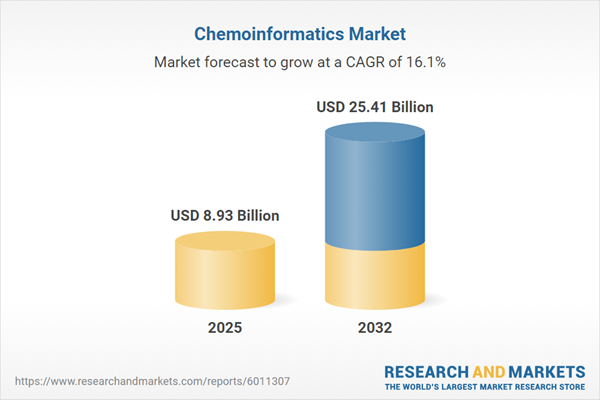Speak directly to the analyst to clarify any post sales queries you may have.
The chemoinformatics market is fundamentally reshaping digital transformation for research-driven enterprises, offering actionable solutions for better decision-making in discovery, compliance, and operational efficiency. Modern informatics empowers leadership teams to streamline processes, enhance collaboration, and adapt to emerging scientific and regulatory frameworks.
Chemoinformatics Market Snapshot: Size, Growth, and Momentum
Valued at USD 7.70 billion in 2024, the global chemoinformatics market demonstrates strong momentum, with projections reaching USD 8.93 billion in 2025 and advancing to USD 25.41 billion by 2032. This growth, reflecting a CAGR of 16.08%, is accelerated by increasing adoption in drug discovery, materials science, and agrochemical sectors. Executives are investing in advanced computational infrastructure and transitioning toward next-generation software solutions. Cloud-based chemoinformatics, process automation, and operational compliance are now top priorities as businesses face swiftly evolving research and regulatory demands.
Chemoinformatics Market: Scope & Segmentation
- Service Types: Consulting, implementation, support, maintenance, and training services ensure that organizations can manage complex scientific workflows with greater research productivity and seamless technology transitions.
- Software Solutions: Data management platforms, molecular modeling suites, predictive analytics, and chemical visualization tools create a scalable framework for high-impact research and innovative science.
- Deployment Models: Choices between cloud and on-premise deployment provide organizational flexibility for data privacy needs, compliance requirements, and cost management strategies.
- Application Areas: Chemoinformatics powers pharmaceuticals, agrochemicals, and materials engineering sectors by enabling accelerated hypothesis testing, rapid project cycles, and responsive adaptation to market shifts.
- End Users: Academic teams, biotechnology firms, contract research organizations, chemical manufacturers, and large pharmaceutical companies depend on chemoinformatics to improve research outcomes and market adaptability.
- Geographical Coverage: Adoption trends are influenced by regional factors such as local regulations and digital infrastructure, shaping strategies across North America, Latin America, Europe, the Middle East, Africa, and Asia-Pacific.
- Company Analysis: Key providers—including Dassault Systèmes SE, Schrödinger, Certara, OpenEye Scientific, ChemAxon, Dotmatics, BioSolveIT, PerkinElmer, Cresset BioMolecular Discovery, and MolSoft—deliver targeted solutions to address scientific and enterprise challenges.
Chemoinformatics Market: Key Takeaways for Senior Decision-Makers
- Automated chemoinformatics and integrated digital lab solutions help reduce manual interventions, enabling strategic focus on core scientific objectives.
- Diverse deployment options, including cloud and on-premise environments, facilitate compliance management and scaling while adapting to evolving regulatory frameworks.
- Application of in silico screening and advanced digital validation methodologies supports risk reduction, ensuring operational continuity during shifting compliance pressures.
- Collaborations with academic institutions and technology partners expand access to diverse data sets and multidisciplinary expertise, driving shorter innovation cycles.
- Centralized informatics platforms foster global project collaboration and knowledge sharing, improving coordination across geographically distributed research teams.
- Adaptable technology strategies empower organizations to address regional compliance and digital landscape variations, enhancing competitive positioning and research agility.
Tariff Impact: Market Adaptations Since 2025
In response to new tariffs set in 2025, organizations revised procurement models, diversified supplier relationships, and refined research workflows. Greater adoption of cloud-based chemoinformatics has streamlined customs logistics and improved regulatory adherence. These measures have contributed to greater research continuity and operational flexibility for international enterprises, supporting more effective resource management and ongoing compliance with evolving trade policies.
Methodology & Data Sources
This report integrates insights from industry leaders, technical experts, and scientific authorities. Data are sourced from peer-reviewed publications, patent analyses, company disclosures, and expert interviews, ensuring comprehensive coverage across all market dimensions.
Why This Report Matters
- Executive leaders can pinpoint high-value segments and regional patterns to inform investment and resource planning.
- Guidance on deploying hybrid cloud solutions and advanced analytics equips enterprises to maximize efficiency and rapidly adjust to market movements.
- Evidence-based recommendations strengthen resilience and support long-term, sustainable growth strategies in research-intensive sectors.
Conclusion
Chemoinformatics is central to research advancement and responsive market operations, enabling organizations to effectively navigate regulatory transitions and maintain an edge in innovation-driven environments.
Additional Product Information:
- Purchase of this report includes 1 year online access with quarterly updates.
- This report can be updated on request. Please contact our Customer Experience team using the Ask a Question widget on our website.
Table of Contents
3. Executive Summary
4. Market Overview
7. Cumulative Impact of Artificial Intelligence 2025
List of Figures
Companies Mentioned
The companies profiled in this Chemoinformatics market report include:- Dassault Systèmes SE
- Schrödinger, Inc.
- Certara, L.P.
- OpenEye Scientific Software, Inc.
- ChemAxon Ltd
- Dotmatics Ltd
- BioSolveIT GmbH
- PerkinElmer, Inc.
- Cresset BioMolecular Discovery Ltd
- MolSoft, LLC
Table Information
| Report Attribute | Details |
|---|---|
| No. of Pages | 191 |
| Published | November 2025 |
| Forecast Period | 2025 - 2032 |
| Estimated Market Value ( USD | $ 8.93 Billion |
| Forecasted Market Value ( USD | $ 25.41 Billion |
| Compound Annual Growth Rate | 16.0% |
| Regions Covered | Global |
| No. of Companies Mentioned | 11 |









